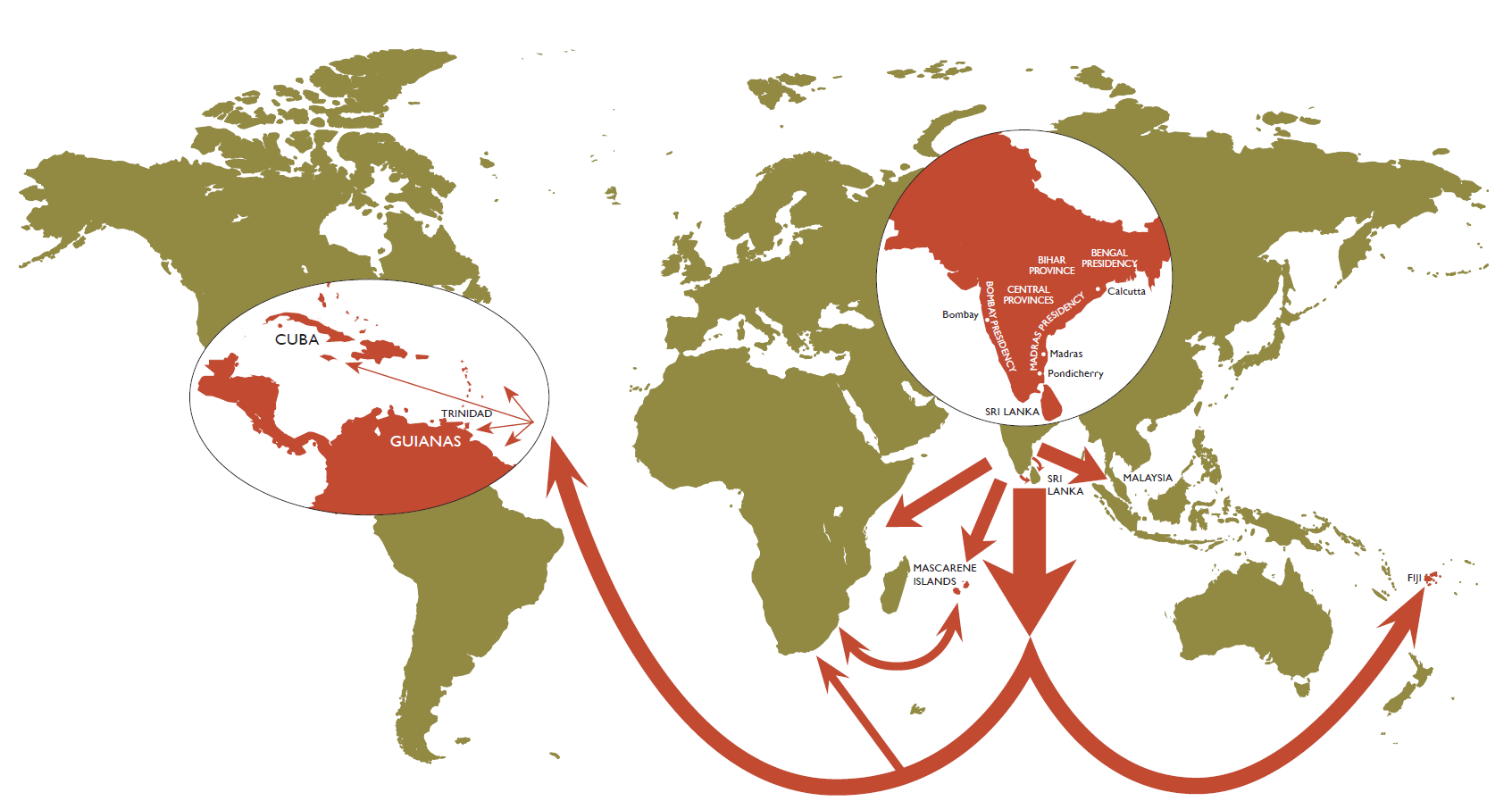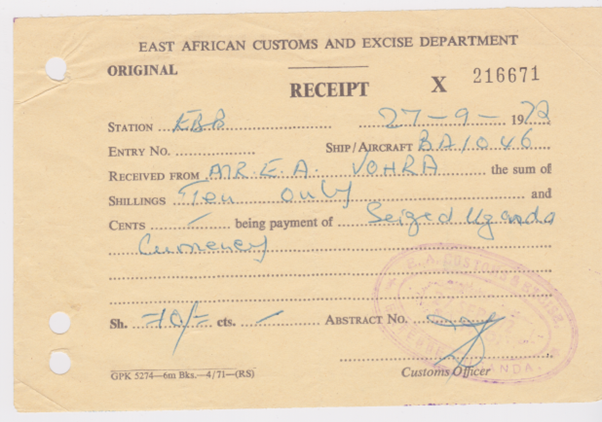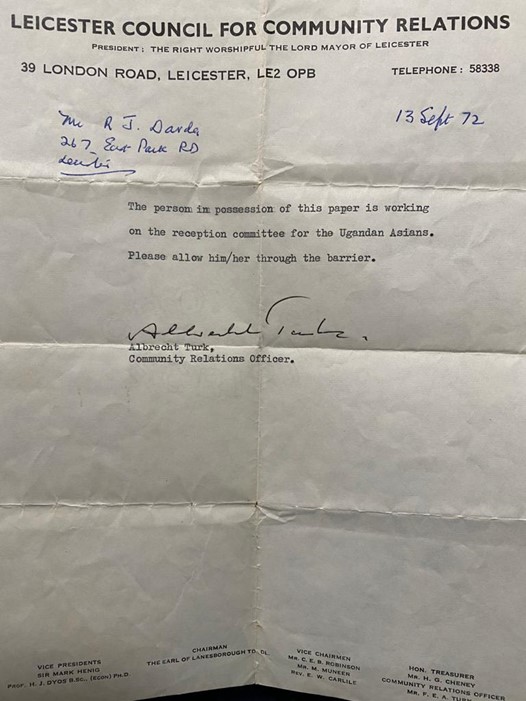As part of our redevelopment of Station Hall—due to open in Spring 2024—we have been looking into the expulsion of Asian communities from Uganda in 1972.
Fifty years since this seismic moment and its aftermath—not only in African and Asian but also British history—it is being commemorated across the nation through events, performances and exhibitions that are celebrating, remembering and creating important records of the history and legacy of the expulsion.
But how does the history of the Ugandan Asian community intersect with British railways? From the man-eating lions of Uganda’s Lunatic Line to the misty hills of Tonfanau in Wales and beyond, Ugandan Asians and British railways both here and in East Africa have a long and curious history beginning in the late 19th century.
South Asian communities and labour migration
South Asian and the Indian subcontinental communities were a useful and ‘cheap’ source of labour under the British Empire, with many of them motivated to migrate to escape crippling poverty and famine. By the early 19th century, the Indian Indentured Trade came to replace the lost black indentured labour following the ‘official’ abolition of the slavery in 1834. The South Indian indentured labourers, known by the socially negative and racist term ‘coolies’, were transported by boats to work on sugar plantations across the world including Africa, the Caribbean and Mauritius. They played an important part in allowing the British Empire to retain control over their enslaved labour-led enterprises, with other South Asian communities also labouring on tea plantations in Assam and rubber plantations in Malaysia.

So how do we then get to railways in East Africa? The history of Asian communities in the region stems back to the late 19th century and British-owned railway construction. Workers from British India, largely Sikhs from the Punjab, constructed the infamous 600-mile railway that linked Uganda and Kenya with the port of Mombasa on the Indian Ocean. This metre-gauge railway became known as the ‘Lunatic Line’, a name coined by one of the line’s opponents, British politician Henry Labouchere. He considered the line directionless and an irresponsible use of public money, which was granted following a campaign that portrayed the line as necessary to the aims of the British Empire—a view questioned by Labouchere and fellow sceptics.

While the railway’s forecasted cost was expensive, this should not overshadow its toll on human life. Because of the line’s increasing financial burden, British officials sought to cut costs wherever possible, including labour relations. Consequently, the line’s purported importance to the British Empire’s wider strategy was used to justify abusive working conditions in an already perilous environment. Well-known examples of this are the ‘man-eaters of Tsavo’—lions that stalked the Kenyan savannah who are said to have killed between 28-100 Asian workers during the line’s construction. Other workers, including Africans, died of disease and heat exhaustion due to insufficient protection and the unrelenting desire of colonial officials to minimise labour expenses.
The political urgency to complete the line also meant that restrictions on the emigration of Asian workers were wavered. The resulting changes in legislation permitted the large influx of migrant workers from British India. By March 1901, the number of Asian ‘coolies’ employed to build the railway reached a peak of nearly 20,000. Of the total 32,000 or so workers who migrated from India over the course of the railway’s construction, 2,493 are reported to have died in East Africa and 6,454 were severely injured.
THE ENDING OF EMPIRE
Around 6,724 of the Asian workers who migrated to help build the railway stayed in East Africa after its completion. By the mid-20th century, some of these Asian communities had settled in Uganda and East Africa more broadly, although many lost their direct connection with the railways. Opportunities for ‘small’ trading built on networks of Asian merchants that had been established and flourished in the late 19th century, including those of Goan traders. These trading links led to many profitable enterprises run by Asian entrepreneurs. Some of these capitalised on a proximity to railway lines and the traffic it provided. Others established businesses at a distance from the railway, instead relying on former caravan routes for communications.
Alongside growing trade networks, many Asians in East Africa found employment on the railways in the mid-20th century. This included positions with Kenya and Uganda Railways, a British-operated railway administration that merged with Tanganyika’s railway and ports services in 1948 to become East African Railways and Harbours. The administration’s Asian employees worked alongside Europeans and Africans in a variety of roles, with many becoming locomotive drivers for goods trains that ran along the original Kenya-Uganda line. After the Second World War, this became a key route for the export of goods and therefore required powerful engines. The majority of locomotives operating in East Africa post-1945 were built to order by former British manufacturers, such as the ‘59 Class’ steam locomotives made by Beyer-Peacock in Manchester.

The day-to-day running of East Africa’s railways was less dangerous than its construction, but workers still faced hazards on a daily basis. In response to these continuing dangers and other work-related disputes, the Railway Asian Union was formed to provide a means for Asian workers to collectively demand better conditions. Workers also formed social groups through societies and sports teams associated with the railway and publicised in the railway administration’s staff magazine.
As the ‘wind of change’ swept across Africa in the 1960s, East Africa’s constituent territories formally declared independence from British rule—Tanganyika in 1961, Uganda in 1962 and Kenya in 1963. Tanganyika merged with Zanzibar after it declared independence in 1964, becoming Tanzania. While some Asian workers migrated to Britain as East African independence neared and during the immediate post-independence years, many continued to contribute their expertise to railway operations in Kenya, Uganda and Tanzania throughout the 1960s and beyond.
Idi Amin’s expulsion order
Following their independence from Britain, Uganda saw a lot of political unrest as the central government battled with the remaining and largest kingdom in the region, Buganda. The power struggle between the Buganda kingdom and the central government concluded with Milton Obote’s central government creating a new constitution declaring Uganda as a republic, abolishing the traditional kingdoms, and declaring Obote as the first president of this new republic. Following a military coup in 1971, Obote was deposed by General Idi Amin Dada, President of the Second Republic of Uganda, who ruled as a dictator over the country until 1979. This political context shadows the devastating situation that led to the forced migration of our Ugandan Asians.
Fifty years ago today, on 4 August 1972, Amin ordered that all Asians in Uganda had 90 days to leave the country. As part of an ‘Economic War’, Amin believed the expulsion and possession of Asian-held assets meant “ordinary Ugandans could become masters of their destiny, enjoy the wealth of their country, and be in control of Uganda’s economy for the first time in the country’s history” (Makubuya, 352).
Having only 90 days to leave the country, around 30,000 of the 80,000 Ugandan Asians in the country came to Britain. Packing as much as they could into the one suitcase they were allowed each, several families were on the first chartered planes they could arrange out of Uganda to come to Britain—the first of which left the country on 17 September—with others going to India, other European countries, North America and Canada. With their former connection to the Empire and British-owned industries in East Africa, many Ugandan Asians came here as they already held British passports.
Leaving on 27 September 1972, and only 12 years old at the time, Prof. Akbar Vohra recalls the experience of travelling to Britain:
I can remember we needed to have a police escort, which my parents paid for, as part of a coach to make sure that we didn’t get looted during the 22-mile journey from Kampala to Entebbe airport. When we got to Entebbe, I can remember being taken into a room and strip-searched by someone who asked if I had any jewellery, or any valuables given to me by my dad. And I just showed him my magnet and my favourite blue marble, and said “that’s all I’ve got”… Arrival was a big shock, I was still in shorts when we arrived in the evening at Stansted airport. We got off the plane, and my knees were virtually knocking as the cold really hit us from the difference of temperatures from Uganda to there. I remember we picked up our cases—we were only allowed one suitcase and £50—and my dad had also brought a number of umbrellas with him. One of the chaps who was helping us said to another one, and laughed about it, “they must think it always rains in England”

(Re)settling in Britain
The Uganda Resettlement Board (URB) was swiftly pulled together to support the Ugandan Asians as they fled the country. It was created as a national agency with executive powers to organise the reception of the expelled community.
With the collective work of the British Government, local authorities and volunteers, from the 18 September (the first flight from Uganda arrived) to 8 November 1972 (President Amin’s deadline), the URB transformed 16 former armed force bases across Britain into resettlement camps for the incoming expellees. These volunteer-run camps provided temporary accommodation, food, education, healthcare and support for employment and finding permanent housing for around 22,000 people.

Ugandan Asians who had already migrated to Britain before Amin’s expulsion order also played an important role in the resettlement process. Rajni Davda (author and former radio presenter for Sabras Radio) along with around 20 other Ugandan Asians, volunteered to be part of the reception committee. Rajni welcomed and chauffeured people from Leicester railway station, carrying with him a letter written and signed by the Lord Mayor of Leicester to grant him access to collect them. This important work had a huge impact on safely welcoming the incoming refugees.
Perhaps the furthest from the flora, fauna and climate of Uganda, Tonfanau in North Wales was the third largest of the resettlement camps, housing up to 1,200 expellees. Travelling a long way to this distant former army camp, the railway was an important tool in the resettlement of the Ugandan Asians who were temporarily housed in Tonfanau. Following their initial journey, the railway was also an important gateway for the community to find and travel to employment opportunities and accommodation, and for leisure during their time in North Wales. Run primarily by local volunteers, some of the expellees made lifelong friendships with residents the resettlement camp who welcomed them in and assisted them during this difficult time.
Other families had their own arrangements for accommodation, with the railways as an important means of travel to their new homes. The Muru family and their neighbours packed through the night into the early hours to take the first flight out of Uganda to England. They were captured on camera on the final leg of their journey at Bishop Stortford railway station as they waited to travel to Birmingham to stay with family already living in the country. However, the resettlement in Britain wasn’t easy for all—the father of the Muru family could not adjust to their new living situation and left to live by himself in India for 25 years until his death in 2018.
Overall, between September 1972 and December 1973, £6.1 million was spent by the URB on reception and resettlement. Of this, £62,200 was spent specifically on general transport expenses for travel from airports by rail and road, as well as for transfers between centres to facilitate closures. The range of resources pulled together by the government and voluntary groups was critical for the safe resettlement of the Ugandan Asians at this time of massive upheaval and uncertainty.
Legacy
50 years after the expulsion, where are we now and how will this fit into our stories at the NRM? The Ugandan Asian community has thrived in countries across the world, and Britain has seen the great strength of this displaced community across our culture, society, economy, public services and more. The resilience of this community and the pride they have in what they have achieved since 1972 is palpable and inspiring. From a history of indentured labour and perilous railway building in East Africa to train journeys across Britain to start new lives, the railways have played a role in the history and legacy of this community.
This story of the Ugandan Asian expulsion, the role of railways in this journey of forced migration, and the starting new lives so far away from home will feature in our redeveloped Station Hall alongside those on the Windrush arrivals at Waterloo station and the Kindertransport of the Second World War. In creating these stories, we recognise the critical importance of decentralising and defusing power and working with the aforementioned communities we will tell the stories of, putting them front and centre of conversations and eventual outputs. For example, working in collaboration with related communities and anniversary groups, particularly British Ugandan Asians @ 50 group who have been a powerhouse network providing invaluable content and contacts, we have enriched our stories on migration for blogs like this as well as for our permanent exhibitions.
We are still actively looking for stories related to these three instances of (forced) migration and their connection to the British rail industry, and would love to hear your stories and see your memories of these particular events. Please contact search.engine@railwaymuseum.org.uk if you have anything you’d like to share with us.
Related links and useful resources
Though you will have to wait until 2024 to see this story our newly-designed Station Hall, if you want to learn more there are plenty of wonderful resources that delve into this extraordinary migratory community, a sample of which you can find below.
Ashutosh Kumar, Marina Carter and Crispin Bates, The Indian diaspora labour, University of Edinburgh Press, 2017 (produced by the ‘Becoming Coolies’ research project on the origins of Indian overseas labour migration based at Edinburgh and Leeds Universities and funded by the Arts and Humanities Research Council [AHRC]
BBC, A very British history: Ugandan Asians. BBC 1, Series 1, December 2018. (Chef and writer, Meera Sodha, delves into the family’s history as Ugandan Asians)
British Ugandan Asians @ 50 – keep an eye on this site for their events and content. You can also find them on Twitter @UgandanAsians50 and Instagram @BritishUgandanAsians50
Davda, Rajni “Blue”. Delhi to Dover: An extraordinary journey.
Hill, M.F. Permanent way: The story of the Kenya and Uganda Railway. Nairobi, East African Railways and Harbours, 1949.
Leicester Museums and Galleries, Rebuilding Lives: 50 Years of Ugandan Asians in Leicester. (exhibition produced by Navrang Arts, funded by National Heritage Lottery Fund & supported by Arts Council England) – find them on social media @Uganda2Leic50
Makubuya, Apollo N. Protection, patronage, or plunder? British machinations and (B)uganda’s struggle for independence. Newcastle Upon Tyne, Cambridge Scholars Publishing, 2019
Mohamed Amin Foundation, ‘Ugandan Asians exodus‘, Google Arts & Culture
The National Archives, ‘Ugandan Asians 40 years on’ project – a wonderful set out resources from the 40th anniversary of the expulsion
Patterson, J. H. The man-eaters of Tsavo and other East-African adventures. London, Macmillan, 1963. (There are several editions of this including eBook versions)
Ruchman, S. ‘Colonial construction: Labor practices and precedents along the Uganda Railway, 1893-1903’. International Journal of African Historical Studies 50, no. 2, 2017: 251-273

Hello
I have written a series of articles about the Uganda Railway and its successors on my blog (rogerfarnworth.com) these may well be of interest to readers of this article. They follow both the history of the line from Mombasa through to the Western borders of Uganda and follow the route of the line and its various branches.
An excellent publication featuring extensive knowledge and research. As a young graduate from Makerere University, Kampala, I was deeply disappointed by the Ugandan Asian expulsion because I saw a great future in a career in academia at the university, one of the most reputable in Africa and recognised internationally. The expulsion deprived older Asians of a safe a cheaper retirement but many began to realise that the benefits in Britain were very generous.